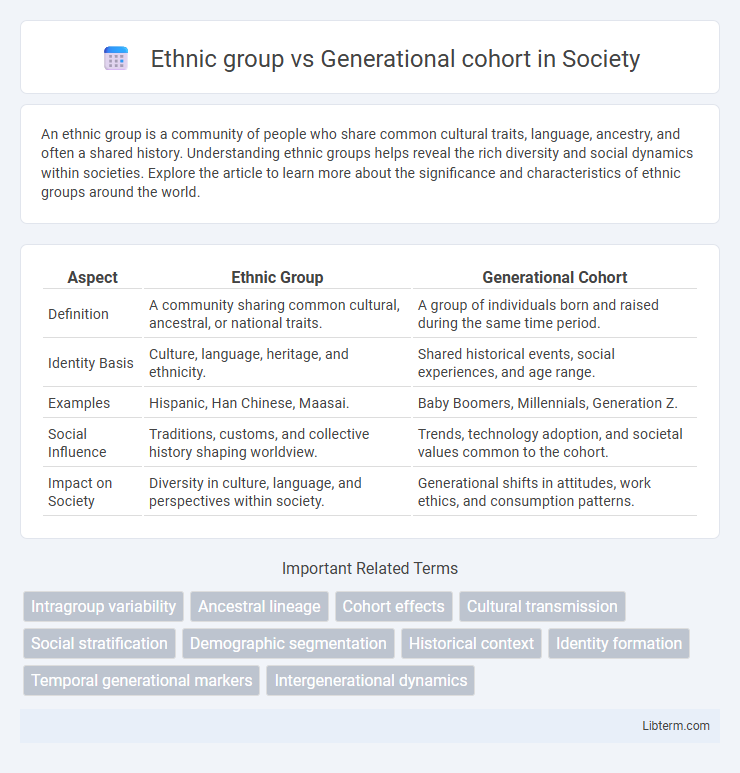An ethnic group is a community of people who share common cultural traits, language, ancestry, and often a shared history. Understanding ethnic groups helps reveal the rich diversity and social dynamics within societies. Explore the article to learn more about the significance and characteristics of ethnic groups around the world.
Table of Comparison
| Aspect | Ethnic Group | Generational Cohort |
|---|---|---|
| Definition | A community sharing common cultural, ancestral, or national traits. | A group of individuals born and raised during the same time period. |
| Identity Basis | Culture, language, heritage, and ethnicity. | Shared historical events, social experiences, and age range. |
| Examples | Hispanic, Han Chinese, Maasai. | Baby Boomers, Millennials, Generation Z. |
| Social Influence | Traditions, customs, and collective history shaping worldview. | Trends, technology adoption, and societal values common to the cohort. |
| Impact on Society | Diversity in culture, language, and perspectives within society. | Generational shifts in attitudes, work ethics, and consumption patterns. |
Understanding Ethnic Groups: Definition and Scope
Ethnic groups are defined by shared cultural traits, language, ancestry, and common heritage, influencing social identity and community belonging. Unlike generational cohorts, which are categorized by birth years and shared historical experiences, ethnic groups encompass deeper cultural connections and traditions passed through generations. Understanding ethnic groups requires examining their social structures, values, and collective history to appreciate their distinct societal roles and interactions.
What is a Generational Cohort?
A generational cohort refers to a group of individuals born within a specific time frame who share common experiences, values, and cultural touchpoints shaped by historical events and societal changes. Unlike ethnic groups, which are defined by shared ancestry, language, or cultural heritage, generational cohorts are characterized by age-related influences affecting their attitudes and behaviors. Examples include Baby Boomers, Generation X, Millennials, and Generation Z, each identified by distinct economic, technological, and social milestones.
Key Differences Between Ethnic Group and Generational Cohort
Ethnic groups are defined by shared cultural, linguistic, and ancestral traits, whereas generational cohorts are categorized based on birth years and shared historical experiences. Ethnic identity influences language, customs, and social practices, while generational cohorts shape attitudes, values, and behaviors influenced by socio-economic conditions during formative years. Understanding these differences is essential for sociologists and marketers to tailor communication and engagement strategies effectively.
Historical Context of Ethnicity and Generations
Ethnic groups are shaped by shared ancestry, cultural traditions, and historical experiences that define collective identity over centuries, reflecting migration patterns, colonization, and social struggles. Generational cohorts, such as Baby Boomers or Millennials, are defined by their birth periods and the socio-political events and technological advancements that influenced their collective attitudes and behaviors. Understanding the historical context of both ethnicity and generations helps explain cultural continuity and change, intergroup relations, and the evolving nature of identity across time.
Sociocultural Identity: Ethnicity vs. Generation
Ethnic groups form sociocultural identities rooted in shared ancestry, language, traditions, and historical experiences, influencing values and community bonds. Generational cohorts develop identity through shared temporal experiences, such as economic conditions, technological advancements, and significant cultural events that shape collective attitudes and behaviors. Ethnicity emphasizes inherited cultural heritage, whereas generational identity reflects the impact of specific sociohistorical contexts on group perspectives.
Influence on Values and Beliefs
Ethnic groups profoundly shape values and beliefs through shared cultural heritage, traditions, language, and religion that create a collective identity influencing worldview and behavior. Generational cohorts, defined by their unique historical and social experiences during formative years, develop distinct attitudes, priorities, and belief systems reflecting contemporary events, technology, and societal changes. The intersection of ethnic identity and generational influences results in complex value matrices where cultural continuity interacts with evolving generational perspectives.
Impact on Communication Styles
Ethnic groups influence communication styles through culturally ingrained language patterns, nonverbal cues, and context sensitivity, while generational cohorts shape communication preferences based on shared experiences with technology, social norms, and information consumption habits. Cultural values from ethnic backgrounds often dictate directness, formality, and conversational pacing, whereas generational differences affect openness to digital communication platforms and multitasking behaviors. Understanding both ethnic and generational impacts enhances intercultural and intergenerational communication effectiveness in diverse settings.
Role in Social Research and Demographics
Ethnic group and generational cohort serve distinct roles in social research and demographics by offering different lenses to analyze population characteristics. Ethnic groups provide insights into cultural heritage, identity, and social experiences, which are crucial for studying issues related to race, inequality, and migration patterns. Generational cohorts enable the examination of shared historical experiences and values within age groups, helping researchers understand social change, consumer behavior, and intergenerational dynamics.
Challenges in Comparison and Classification
Challenges in comparing and classifying ethnic groups versus generational cohorts arise from differing bases of identity--ethnicity centers on shared cultural heritage, language, and ancestry, while generational cohorts are defined by birth years and socio-historical experiences. Ethnic group classifications often face complexities due to mixed heritage and evolving self-identification, whereas generational cohorts struggle with fluid boundaries and overlapping characteristics across age ranges. These distinctions complicate data analysis, policy-making, and social research, requiring nuanced approaches to accurately capture diverse population dynamics.
Integrating Both Perspectives in Modern Society
Ethnic group and generational cohort both shape identity, influencing cultural values, communication styles, and social behaviors in modern society. Integrating these perspectives enhances diversity and inclusion initiatives by addressing the unique experiences of various age groups within ethnic communities. Policies and social programs that consider both ethnic background and generational differences foster greater understanding and cohesion in multicultural environments.
Ethnic group Infographic

 libterm.com
libterm.com